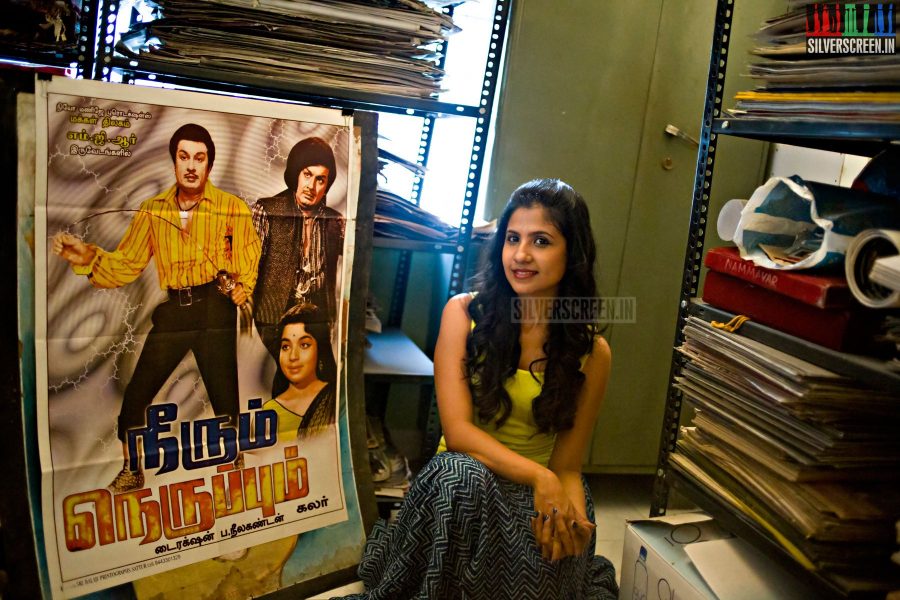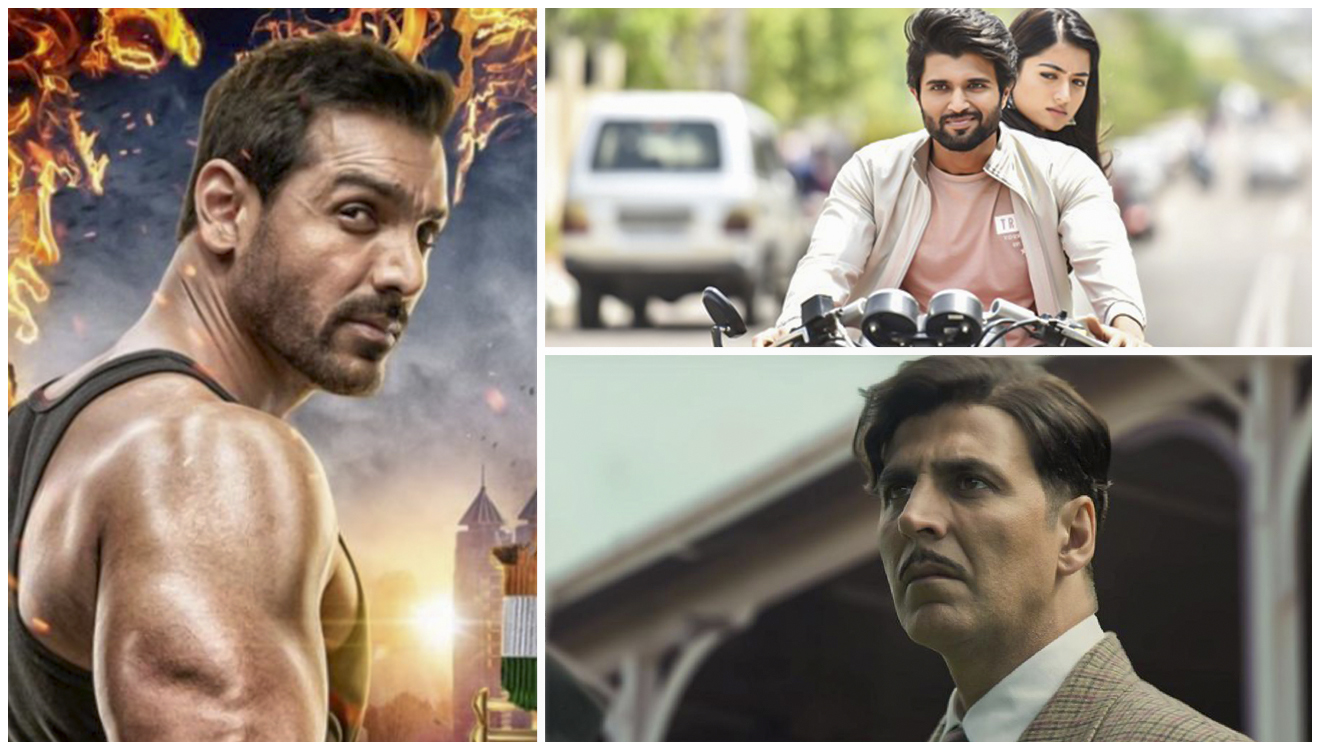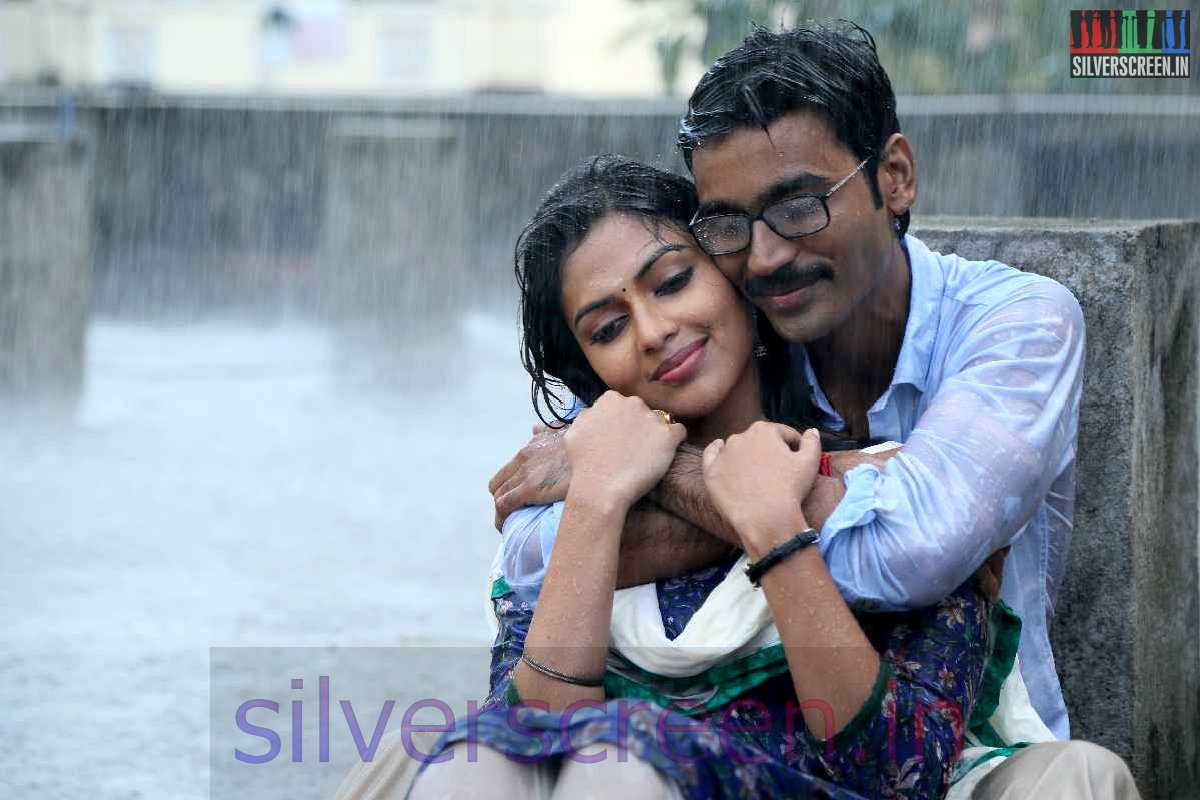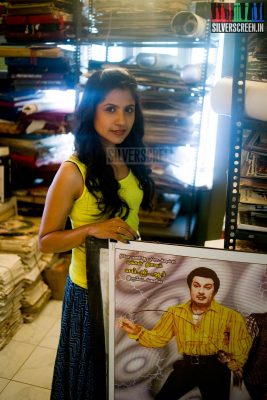
Sruti Harihara Subramanian, founder of The Cinema Resource Centre
The Cinema Resource Centre is on the first floor of an apartment building in Alwarpet, right next to a popular bistro. “We lost electricity. So need to wait a couple of minutes to switch on the generator,” she says apologetically as we head up a staircase to a brightly-lit space.
The apartment has large windows and white-washed walls.
It also has many stories to tell.

The Cinema Resource Centre Artifacts
“I found this cupboard on the street. Someone probably just abandoned it,” she explains, before pointing to a painting in the room. It is a hand-painted poster of the Hindi film Garb. “That poster was used to line the drawers. Maybe this cupboard belongs to an artist who painted film posters,” she speculates. “We reworked this cupboard so we can store our posters here.”
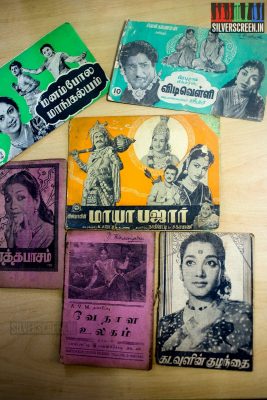
The Cinema Resource Centre Artifacts
We notice Thalapathi‘s song book. Sruti explains that the book didn’t come from official sources. “Do you see Rajini’s picture on this book? He didn’t look like this in the movie. They seemed to have used an old photo.” Sruti was ecstatic when she managed to find the cover of the song book of the Tamil film Chandralekha. “It’s an iconic film. I could get only the jacket. But I am sure it’s from the makers. It is huge and in colour,” she says, smiling. She hopes to find the book one day.
Sruti doesn’t have any special sources in the industry for her artifacts. Her friends and acquaintances know her love for collectibles, and hand her whatever they can. “One of my friends gave this Deepavali Malar to me. They were cleaning up their house and his mother had this copy.” Sruti shows us the Deepavali special edition of a Tamil magazine that was printed in 1959.
The closet also houses a heap of lobby cards. “Now we have LED screens in cinema lobbies. Those days, these stills were placed in the lobbies for promotion.” We spot the lobby cards of Karnan, Sorgam and Bhagya Lakshmi. In another closet in the same room, there are many old photo albums. “These are albums of candid pictures from film shoots,” she tells us, “It was done for every film.” The photo albums were used as reference points for continuity. “Filmmakers still create an album for their films, but now it is mostly for sentimental reasons,” she observes. She shows us glass slides that were used to display ads during intervals and LPs of films like Parasakthi, Veerapandiya Kattabomman and Kadhalikka Neramillai. And we can only see. Sruti doesn’t allow us to lay our hands on any of her relics. “I’m sorry. But they are precious,” she grins, as she locks them back up again.
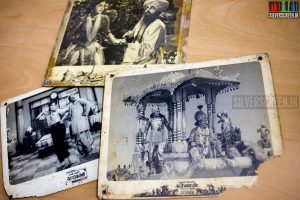
The Cinema Resource Centre Artifacts
Most of her posters were collected from garbage. “What couldn’t be used anymore has become our precious collection. Now everybody who works on posters, drops them off here. But for the moment, I have stopped acquiring more posters because of lack of funds and space. And we are currently focusing on cataloguing and digitising our current collection.” The packed-room also houses creatively made invites of audio-launch and stickers of stars’ pictures that were released by fans. We spend more time seeing the posters before going down to the bistro to listen to Sruti’s story on how it all started.
Sruti has hardly any memory of watching movies when she was young. “I don’t come from one of those families that would pack snacks and go to the movies often. I only remember watching Dennis the Menace and Willow,” she laughs. There were a few VHS tapes at home and that was it.
But she discovered her love for cinema when she visited her grandma in Kerala during her summer holidays. “When my cousins didn’t join me in Kerala during the holidays, I had no company. So I ended up watching a lot of Malayalam films. I watched films by Fazil and Priyadarshan; Mammooty and Mohanlal. And that’s when I fell in love with cinema.” Sruti went to high school and began to watch films in theatres with friends. “I was struck by the grandeur of cinema. I was fascinated by how we could be drawn into another world.” That was the time Mani Ratnam was doing films with AR Rahman, Sruti recalls. “If I learned that there was an AR Rahman or Mani Ratnam interview in a magazine, I would rush to Landmark to get a copy. I would read their interviews over and over. Preserve my copy with care.”
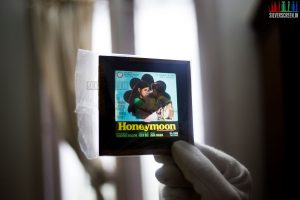
The Cinema Resource Centre Artifacts
A lot of her pieces were collected from Anand Theatres when it was on the verge of being demolished. Sruti was at the theatre, assisting actress Revathy, whose Ability foundation used to conduct a film festival at Anand. Sruti found so many posters ready to be discarded that her heart bled. “I couldn’t see such nice stuff being thrown away. To me, it looked like a hurt animal on the street. How could I ignore them? I picked up all of it and added to my collection.”
Recently, Sruti added all the photo albums that were created for the film Aval Appadithaan to her collection. “The photo albums are very close to my heart. I am glad I managed to collect the entire album. And that process of collecting it taught me a few things,” she says. “I watched the film, researched about it. The film features Kamal Haasan, Rajinikanth and Sripriya. Because of radical feminist elements in the movie, one often thinks that it was directed by K Balachandar. But it was made by Rudhraiya. Such trivia matters a lot to me. And I wonder how Rudhraiya could make such a film in 1978. Kamal Haasan was a documentary filmmaker and Rajinikanth was an ad guy. The script was refreshing…” Sruti observes that Aval Appadithaan may not be as old as some of the other films in her collection, but managing to get all the photo albums of the film make the movie special to her.

sruti-subramanian-cinema-resource-center-artifacts-006
“I’m often afraid that I have so much responsibility. I hope we fulfil all our dreams when we get our grants.” Although the preserving process is expensive, Sruti is sure that she will not ask anyone from the industry for donations. “I haven’t tried asking for support. It is a personal effort. But I couldn’t contain the secret. Some people from the industry who found out about us have encouraged our efforts. But we would be happy if people come on their own to help us,” she says.
Sruti harbours big dreams for TCRC – an exclusive museum for cinema. “What you see now is a very small part of our plan. We have a long way to go to make our dreams come true,” she says.
“We say India is a land of culture. However we don’t do much to preserve our culture. Sometimes I feel we are hypocritical that way,” Sruti reckons. When she explains to people that she needs money to preserve her collection, “they say they would rather feed or educate a child first and then think of animal welfare and culture. It is very difficult to convince and make them understand the importance of cinema too.”
“I visited a cinema museum in Amsterdam recently. It was bustling with activity. Interactive sessions with filmmakers and discussions on cinema. When I spoke to people there, they only recognised Bollywood. I had to tell that Indian cinema is not just Bollywood. That’s why TCRC focuses on south Indian cinema,” she says.
Recommended
Sruti plans to conduct cinema-related activities when TCRC sets up their own space. “In India, cinema is popular. But other than watching the movie, the average moviegoer does not know what goes into making a movie. Cinema and the public should have a different kind of relationship. There has to be a dialogue. In our own space, we want to screen movies, conduct workshops, host curated shows of memorabilia, and open a library.”
Sruti assures us that it won’t be like a regular museum, but a cool place to hang out. “It would be like a cafe. And that’s my long term plan, okay!” We envisage a cafe where one sips filter coffee in a dabara-tumbler while staring at Eastman colour posters of MGR. PB Srinivas singing in the background.
The Cinema Cafe sounds like a plan.
Here is a link to an exclusive gallery of the TCRC collection
The TCRC Story is a Silverscreen exclusive.
